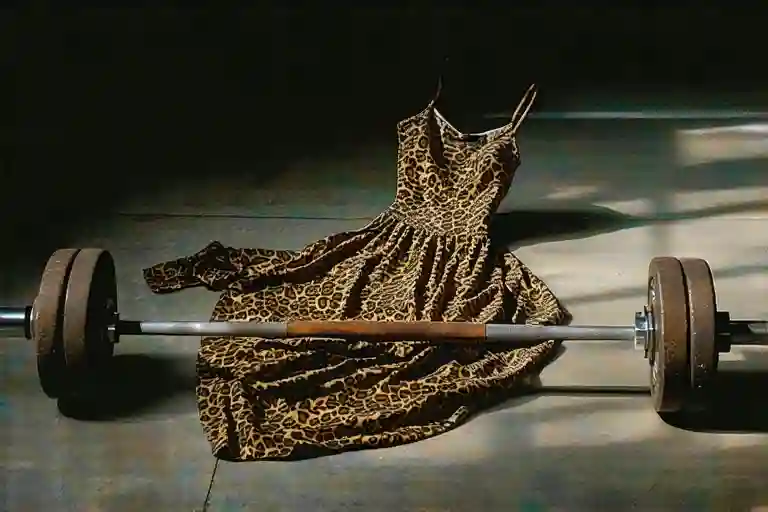The glow of my phone screen was the only light in the room at 1:23 AM when my thumb froze mid-scroll. There she was – a woman I’d never met, radiating confidence in a leopard-print dress that clung to every curve, her stiletto heels angled just so for the camera. The contrast between her sculpted arms and my own loose sleep shirt sleeves felt like a personal indictment.
My finger hovered over the image for half a second too long, that telltale pause where casual browsing turns into something darker. A familiar tightness coiled in my stomach, the kind I used to feel before attempting a personal record deadlift. Except this wasn’t anticipation – it was that ugly, crawling sensation of recognizing envy in real time.
Before I could stop myself, I took a screenshot. Not to save for inspiration later, but to zoom in, to study the details of what I wasn’t. The way the dress dipped to showcase shoulders that clearly knew their way around a pull-up bar. The effortless stack of bracelets on a wrist that had probably never needed a lifting strap. Five years ago, that could have been me.
The rational part of my brain knew this was absurd. She wasn’t a friend, wasn’t even an acquaintance – just someone who appeared in my feed through the mysterious algorithms that govern our digital lives. Yet here I was, heart pounding with something between admiration and resentment, staring at a stranger’s highlight reel while wearing yesterday’s gym leggings that never actually made it to the gym.
What unsettled me most wasn’t her apparent perfection, but the sharp reminder of how much had changed since my last serious powerlifting session. The contrast between her celebratory post and my own abandoned training logs sat heavy in my chest. That photo became a mirror reflecting back all the unkept promises I’d made to myself before life intervened with its series of ‘not right nows’ that somehow stretched into years.
Social media often gets blamed for these moments of unhealthy comparison, but the truth was more complicated. The platform didn’t create my feelings – it simply held them up to the light, forcing me to acknowledge what I’d been avoiding. Her joy didn’t diminish mine; it revealed where mine had gone missing. As I finally set the phone face down on the nightstand, I realized this wasn’t about her at all. That leopard-print dress had simply become the catalyst for a confrontation I’d been postponing with my former self – the woman who used to chalk her hands with anticipation rather than regret.
The Leopard Print Paradox
Her photo stopped my thumb mid-scroll. A leopard-print dress clung to curves I used to have before life reshaped me. The contrast stilettos stabbed at something deeper than my Instagram feed – they punctured that carefully constructed lie we all tell ourselves: I’m fine with how things turned out.
Social media does this cruel magic trick. It takes ordinary moments and polishes them into these impossible ideals. That photo wasn’t just a woman celebrating her fitness – it became a mirror showing everything I’d lost. The muscles I used to flex in gym selfies, the PRs I once bragged about, the version of myself that didn’t wince when tying shoelaces.
The Anatomy of Comparison
Psychologists call it social comparison theory – we define our selfworth by stacking ourselves against others. That night, my brain conducted a brutal inventory:
- Achievement: Her celebratory post vs my abandoned training logs
- Appearance: Her sculpted shoulders vs my hoodie-hidden arms
- Happiness: Her radiant smile vs my screen-lit exhaustion
Here’s what no fitness influencer mentions: every scroll through perfected bodies chips away at your gymcomeback confidence. The algorithm doesn’t show the three failed attempts before that perfect lift, just the triumphant final reel.
The Anxiety Machine
Those platforms are designed to unsettle. They feed on our midlifecrisis insecurities like a personal trainer spotting weakness:
- “You used to lift how much?” (Memory)
- “Could you even deadlift the bar now?” (Doubt)
- “Her quads are what yours looked like pre-kids” (Comparison)
I realized my anger wasn’t about her success – it was grief for the athlete I’d been before jobs, mortgages, and responsibility plates got loaded onto my barbell.
That leopard print dress became more than fabric – it was the embodiment of every “before” photo I couldn’t recreate, every workout skipped for overtime, every time I chose practicality over powerlifting. The stilettos? Just sharp reminders that some women still prioritize their fitness in ways I convinced myself I couldn’t.
What surprised me wasn’t the envy – it was recognizing how deeply I’d internalized the idea that strength had an expiration date. As if turning forty meant trading lifting belts for elastic waistbands. That stranger’s photo forced me to confront the uncomfortable truth: I hadn’t lost my strength to time, but to surrender.
This is the dirty secret of fitnessmotivation culture: sometimes the hardest lift isn’t the weight, but the emotional baggage we attach to starting over.
The Rusted Barbell
The envelope felt heavier than it should have when I pulled it from the mailbox. My 40th birthday present from the universe – a detailed MRI report confirming what my creaking joints had been whispering for months: “Moderate hip degeneration. Recommend low-impact activities only.” I stared at the clinical language until the letters blurred, each term carving deeper than any powerlifting injury ever had.
Muscle doesn’t just fade away quietly after forty. Studies show women lose 3-5% of muscle mass per decade starting at 30, with the decline accelerating after menopause. But numbers never capture the visceral reality – how shower tiles suddenly feel colder against thinner skin, how grocery bags develop mysterious weight overnight. My sports physiotherapist kept saying “muscle memory” like a mantra, but my body seemed to have forgotten the password.
Three weeks after that diagnosis, I stood gripping the empty barbell like it might electrocute me. The gym smelled exactly as I remembered – disinfectant and ambition – but my muscles had become strangers. That first squat descent felt like operating someone else’s body; my knees announced their displeasure with audible cracks that made nearby college students wince. Where I once loaded 120kg without thinking, now the 20kg bar alone made my quadriceps tremble like jelly in an earthquake.
What surprised me wasn’t the physical struggle but the emotional aftershocks. Between sets, I’d catch my reflection in the floor-to-ceiling mirrors – not judging my form, but staring at the woman who’d let five years slip by. The sports bra that used to strain across my back now gaped at the straps, a fabric indictment of my absence. Each dropped weight plate echoed with the same question: Why did you abandon us?
Rebuilding became a daily negotiation between pride and pragmatism. My trainer (a former competitive powerlifter with biceps that could crack walnuts) had me start with bodyweight movements, relearning motor patterns like a toddler. We celebrated microscopic victories – a full range of motion here, thirty seconds more plank time there. The barbell slowly accumulated weight again, but something more important was accumulating too: proof that decline isn’t inevitable, just inconvenient.
Those early sessions taught me that midlife fitness isn’t about reclaiming youth but discovering what your body can become now. The weights might be lighter, but the courage required feels infinitely heavier. Where twenty-year-old me lifted to prove something to the world, forty-year-old me lifts to keep faith with myself – one imperfect rep at a time.
The Alchemy of Jealousy: Turning Envy Into Iron
That screenshot sat in my camera roll like an unclaimed gym bag – bulky, awkward, impossible to ignore. I’d captured her mid-laugh under the gym fluorescents, leopard print clinging to quads that could probably squat my bodyweight. For three days, I kept returning to it with the same morbid fascination one pokes at a bruise.
Then came the breakthrough: instead of deleting it, I printed the photo and taped it to my workout journal. Underneath, in red Sharpie: “This feeling is just unspent energy.” Thus began my experiment in emotional alchemy – converting sticky social media envy into clean kinetic fuel.
The Conversion Rates
I developed a simple exchange system:
- 15 minutes of mindless scrolling = 20 kettlebell swings
- 1 “comparison spiral” session = 3 rounds of sled pushes
- Each screenshot saved = 5 extra minutes on the assault bike
The rules were non-negotiable. That photo of her deadlifting in coordinated lululemon? It earned me 4 sets of deficit reverse lunges. The reel of her protein pancake breakfast? That bought 10 minutes of foam rolling I’d been skipping.
Phone as Gym Equipment
I stopped charging my phone overnight. The dwindling battery became my workout timer – when it hit 20%, that was my cue to trade digital consumption for physical exertion. Some days this meant doing farmer’s carries while listening to lifting podcasts instead of Instagram stories. Others, it looked like leaving my phone locked in the gym locker during entire training sessions.
The pivotal moment came when I caught myself mid-swipe, thumb hovering over her latest check-in. Instead of tapping, I set a 3-minute plank timer. As my core trembled, I realized: This is what engagement really looks like.
Training Journal Revelations
Page 23 of my notebook holds the tear-smudged entry from Week 4: “Today I lifted the empty bar and wept. Not because it was heavy, but because it was light – proof of how much I’d lost.” Two pages later, a different confession: “Didn’t check her profile once during today’s session. PR on overhead press.”
The turning point wasn’t dramatic. Just a Tuesday when I noticed my hands – really noticed them. The calluses from pull-ups, the faded tan lines from lifting straps, the freckle I’d memorized from countless bench press setups. They were becoming mine again, not hers by proxy.
Now when jealousy flares (and it still does), I greet it like an old training partner – acknowledging its presence before getting back to work. Some days it fuels extra reps. Others, it simply reminds me to drink more water and log off earlier. The conversion rates keep changing, and that’s progress.
Because here’s the secret no algorithm will show you: every minute spent measuring yourself against others is a minute not spent becoming stronger. And strength, it turns out, has its own kind of beauty – one no filter can replicate.
The Calloused Truth About Strength
My palms tell a different story than my Instagram feed. Where fitness influencers showcase manicured hands gripping barbells with artful precision, mine bear the topography of a working woman’s journey – two crescent-shaped callouses under each finger, a faint scar from that time the knurling tore through my chalk barrier, and a permanent indentation where the Olympic bar decided to take up residence during a particularly grueling deadlift session.
These marks became my secret rebellion against the filtered reality of #fitspo culture. While others curated their perfect workout selfies, I started photographing the unglamorous artifacts of true strength training: the callous that bled during 100 pull-ups, the barbell rash across my collarbone after cleans, the distinctive quad bruise pattern from squat safeties. These became my badges of honor, more honest than any before-and-after photo could ever be.
Redefining ‘Strong’
Physical resilience was just the surface layer. At 42, I discovered strength manifests in less photogenic ways:
- The courage to regress – Deloading to just the 15kg bar when my form faltered, ignoring the side-eyes from twenty-somethings quarter-squatting triple my weight
- The wisdom to listen – Trading PR attempts for mobility work when my SI joint started singing its warning hum
- The discipline to show up – Those Wednesday 5am sessions where I simply walked on the treadmill for mental health, counting it as a victory over staying in bed
The fitness industry sells strength as perfectly defined deltoids and 200kg deadlifts. But real strength training – especially after 40 – becomes an ongoing conversation between ambition and acceptance. Some days the conversation sounds like adding 2.5kg plates with quiet satisfaction. Other days it’s the profoundly strong act of swapping back squats for goblet squats because your knees deserve kindness.
The Beauty of Unfiltered Progress
I keep a progress journal that would give most social media managers hives. Not a single photo has coordinated leggings or flattering lighting. Page after page documents the messy middle:
- Smudged entries about failing my old warm-up weights
- Coffee-stained notes on form corrections
- Dried sweat marks on pages describing emotional breakdowns mid-workout
This notebook became sacred because it captured what no transformation photo could – the nonlinear reality of rebuilding strength. Where Instagram shows two data points (before/after), my journal held the truth: progress looks like scribbled arrows – some pointing up, some down, most zigzagging sideways.
My coach once said something that stuck: “The weights don’t care about your age, your excuses, or your Instagram likes. They only respond to consistent effort.” That became my mantra whenever comparisonitis struck. Those perfectly posed fitness photos? They’re just single frames from someone else’s movie. My callouses tell the whole story.
The Alchemy of Jealousy: Turning Envy Into Iron
That leopard-print dress photo still lives in my camera roll. Not as inspiration, but as evidence – proof of the afternoon I realized my scrolling thumb had developed its own anxiety tremor. The contrast was almost comical: her sculpted shoulders glistening under studio lights while my own reflection showed sweat stains spreading across an old college gym shirt.
Social media had become my accidental mirror, reflecting not who I was but who I’d failed to become. The realization hit like a missed lift – that sudden drop when the barbell wins. Except this weight was entirely psychological.
The 3-Step Emotional Deload Protocol
- The Screen-Time Squat Test
Before allowing myself to scroll, I perform three bodyweight squats. If my knees crack louder than my phone’s notification tone, the app gets deleted until my next training session. This physical gatekeeper creates space between impulse and action. - The Comparison Conversion Chart
Every twinge of envy gets quantified into workout fuel:
- 1 “Why not me?” = 5 push-ups
- 1 “She’s so perfect” = 10 kettlebell swings
- 1 “I’ll never look like that” = 30 second plank hold
The math is merciful – after two sets, most comparison thoughts exhaust themselves.
- The Unfiltered Progress Pic
For every polished fitness post I admire, I take one raw photo of my own training reality: chalk-stained hands, foam roller bruises, the indentation my lifting belt leaves on my hips. These become my true benchmark images.
The Leopard Print Epiphany
Months later, I found myself staring at that same leopard-print photo with entirely new eyes. The dress hadn’t changed, but my understanding had deepened. What once symbolized unattainable perfection now represented something far more interesting – someone else’s joy that had nothing to do with me.
My gym bag now carries two reminders:
- A printout of my first shaky post-hiatus squat video
- That infamous leopard-print screenshot
Together, they form the perfect counterbalance – evidence that progress and envy can coexist, so long as one fuels the other.
The real transformation wasn’t in my glute development (though that’s coming along nicely), but in recognizing that every filtered photo represents someone else’s Day 1. We’re all just out here, doing our next rep.





